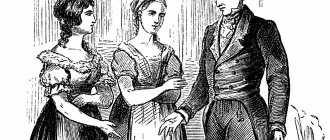M. V. Lomonosov - poet of the era of classicism
1. Reflection of historical events and portraits of great people. 2. The role of mythological heroes. 3. Features of language and style. 4. Education of a harmonious personality. 5. Rational comprehension of the surrounding world.
Learn from everyone - don't imitate anyone. M. Gorky The era of classicism had very strict canons, which the author had to strictly follow when creating a work. He could not mix genres of different styles: high and low. The author had to create an ideal image of a ruler or monarch through not only praiseworthy words, but also with the help of mythological characters, thereby placing mere mortal people on the same level as ancient heroes. Any work had to be based on a rational grain, which made it possible to capture individual images as unique historical pictures of a particular era. One of the brightest representatives of the era of classicism is M.V. Lomonosov. The poet in his works adheres to all the necessary canons of this direction. The ode occupies a central place in his work. And he managed to raise this genre to a fairly high level in his creations. Moreover, it is the ode that is intended to illuminate the life of the state and historical phenomena. Such events are shown through portraits of monarchs or great people (for example, generals). Mainly in the poet's legacy is the appearance of Empress Elizabeth, during whose reign his creative activity took place. But the image of another great sovereign, Peter I, occupies no less place in his works. M.V. Lomonosov devotes both individual texts to him and recalls him in other odes. Thus, Peter I becomes a role model for posterity. In the “Inscription of Commendation to the Statue of Peter,” the emperor appears to us in the guise of a “wise hero,” who is an exemplary sovereign. He does not spare himself so that everything flourishes in his fatherland.
... For the sake of his subjects, depriving himself of peace,
The latter accepted the rank and served as king,
He established his laws by example...
And what is this example? Peter I does not disdain any kind of work: he trains soldiers and takes part in battles himself. But at the same time he never leaves his state unattended. Therefore, he is able to outrun “domestic and external counterparts.” Such actions allow him to be given the high title of “father of the fatherland.” And as the author notes, people living in such a prosperous state remain grateful to him. And so many altars are burning before this vision,
Since there are many hearts that owe him.
The author returns to this historical figure in “Ode on the Day of the Accession to the All-Russian Throne of Her Majesty Empress Elisaveta Petrovna, 1747.” But the central image still remains of Elisaveta Petrovna. Lomonosov creates the ideal image of a nun according to the canons of classicism. In this case, the technique of “imitation of nature” is used, that is, the author personifies the merits of man with nature itself, thereby showing that the empress does everything in accordance with common sense and reason. Let us remember that the most important principle in the aesthetics of classicism was rationalism (from the Latin gayo - reason).
The fence of kings and kingdoms of the earth,
Beloved silence,
The bliss of the villages, the city fence,
How useful and beautiful you are!
In such a description we do not find any individual traits showing that this is Elizabeth. We can determine that it is she only by her deeds that the empress performs in her fatherland. Such a description of a historical figure also becomes an element of classicist writing: portraits are devoid of individual features. Flowers around you are full of colors And the classes in the fields are turning yellow The ships are full of treasures Daring at sea for you; With a generous hand You scatter Your wealth across the earth... Among the characters appearing in the odes, there may be mythological heroes who make it possible to describe the merits of a particular person in an allegorical form. In his works such characters as Mars (the god of war) and Neptune (the ruler of the sea kingdom) appear. In the bloody fields, Mars was afraid, His sword in Peter’s hands was in vain, And Neptune seemed with trepidation, Looking at the Russian flag. In this short passage, the author shows us that even the gods were afraid of the power that the Russian emperor had. But when he had to stand up to defend his homeland, he was able to instill fear even in the Olympian gods. The image of Elizabeth acquires feminine features. She is also shown as a strong sovereign. But when using mythological heroes, Lomonosov compares her breath to marshmallows, a light warm breeze. Although this interpretation of this image appeared later, it initially correlated with the image of the god of the west wind.
But the spirit of her zephyr is quieter, And her vision is more beautiful than paradise. The ode belongs to the high genres, therefore it uses pathetic intonations and high words, such as “dare”, “mouth”. Some of them are borrowed from the Old Church Slavonic language: “zrak”, “grad”, “klasy”, “cold”. In his odes, Lomonosov does not allow a mixture of styles, as it should have been in the era of classicism. Therefore, there are no common expressions in his works, even when the narration is in the first person. I enjoy the happiness of the Russians, I do not change their tranquility, For the whole West and East. Thus, his odes capture historical figures not in their individual uniqueness. They present stable, enduring signs of the sovereign who is in power over time. That is, having ascended the throne and received a royal crown from the Almighty, he works for the good of his people. Lomonosov found similar advantages in the image of Peter I. He notes the same in the image of Elizabeth. When she ascended the throne, As the Most High gave her a crown, She raised you to Russia, Put an end to the war... By creating his odes, he pursued a goal that was obligatory for a classic work. The text was supposed to educate a harmonious personality. Therefore, the author, with the help of historical portraits, shows what young people should be like. At the same time, he directly addresses them: they should take the deeds of Peter and his followers as a model. Consequently, science should occupy one of the main places in their lives. The standard in the classicist ode is ancient examples, such as Plato, the ancient Greek philosopher. The poet emphasizes that sciences help throughout life’s journey, since they remain close to a person at any moment. Sciences are used everywhere, Among peoples and in the desert, In the noise of the city and alone, In sweet peace and work. This is how a harmonious personality is formed, which takes life experience from great historical figures, and new knowledge from books that help to find a common language with any people in different conditions. We have already said that the main thing for classicism is a rational comprehension of reality. That is, followers of this trend do not accept the mystical explanation of various natural phenomena. After all, even every natural manifestation has its own interpretation, which can be described rationally. Lomonosov also addresses this aspect of comprehension of reality in his odes. For example, in “Evening Reflection on God’s Majesty on the Occasion of the Great Northern Lights.” The ode presents a man who finds himself facing the Universe alone. He becomes a small grain of sand in this huge world full of secrets. An abyss full of stars opened;
The stars have no number, the bottom of the abyss.
The author does not show us the features of the main character. He simply says that he is full of different thoughts. That is, the hero is not speculatively, but with the help of various theories, trying to unravel the mystery of the world. He again chooses the rationalistic option of comprehending reality. And in order to understand the laws of nature, he begins to ask himself many questions. The dawn rises from the midnight lands! Doesn't the sun set his throne there? Aren't the icemen putting out the fire of the sea? Behold, the cold flame has covered us! Behold, day has entered the earth in the night! Man manages to get closer to some of the secrets of the world. But nature does not reveal all its cards to him. Therefore, he still has many questions that still need to be answered. Tell me, how expansive is the light? And what about the smallest stars? Ignorance of creatures is the end for you? Tell me, how great is the creator? In the odes of M.V. Lomonosov, all the features of classic works are preserved. The writer does not deviate from the accepted rules, especially since he himself worked on the basics of versification. The poet creates works that are reasonably organized and logically constructed, as it should have been in the hierarchy of classical genres. But even in this monotony, the poet finds his own words and colors to describe those individuals whom he praises in his odes. And, undoubtedly, his poetic creations not only educated the younger generation of that time, but also serve as a kind of standard for us, students of the 21st century, showing how to form a harmonious and fully developed personality in ourselves.
Features of classicism in the poetry of M. V. Lomonosov
In the history of Russian literature, the eighteenth century was marked primarily by achievements in the field of poetry. Among the prominent poets of this era are Vasily Kirillovich Trediakovsky, Alexander Petrovich Sumarokov, Gavriil Romanovich Derzhavin and others. Mikhail Vasilyevich Lomonosov occupies a special place among them. About this outstanding figure of Russian science and culture, Alexander Sergeevich Pushkin said that he “himself was the first Russian university.” The versatility of Lomonosov’s talents and knowledge was manifested both in the reform of Russian versification he carried out, thanks to which Nikolai Vasilyevich Gogol later called him “the father of our poetic speech,” and in his own poetic achievements associated with the literary movement, which was called classicism.
The term "classicism" comes from the Latin word "classicus", which means "exemplary". This literary movement was based on the ideas of the Enlightenment, who put the achievements of reason in the first place in life, and considered the goal of human activity to be the pursuit of an ideal. The world around us does not correspond to the ideal. It must be transformed in the direction the writer needs. Accordingly, the heroes of the works of the classicists could not be ordinary people, but those in whose actions this desire for the ideal was most clearly manifested. That is, first of all, rulers, kings.
In accordance with the requirements of classicism, Lomonosov developed the so-called theory of “three calms”, dividing all literary genres into three categories: high, medium and low. In the field of lyric poetry, the ode became a high genre, and the variety of it that was called the solemn ode. It was intended to glorify and praise the highest achievements of man, to express deep philosophical ideas, as well as to glorify persons standing at the highest levels of society.
An example of a philosophical ode is “Evening reflection on the Majesty of God on the occasion of the great northern lights.” In it, the poet admires the greatness of the Creator of all things, who set man with the task of unraveling the secrets of nature. Turning his gaze to the starry sky, the poet exclaims, amazed by its incomprehensible greatness:
An abyss has opened and is full of stars; The stars have no number, the bottom of the abyss.
And then he suggests that intelligent life exists not only on Earth:
The lips of the wise tell us: There are many different lights; Countless suns burn there, Peoples there and the circle of centuries...
An example of a solemn ode addressed to the supreme rulers of the country is “Ode on the day of accession to the All-Russian throne of Her Majesty Empress Elisaveta Petrovna, 1747.” The form of a solemn ode was for the poet a way of conversation with monarchs and allowed him to express his own ideas about their purpose, about their deeds aimed at the benefit of the Russian state.
Addressing the daughter of Peter the Great, Elizabeth, the poet gives her credit for continuing the work of her father, whom he glorified in his other works, asserting: “It is impossible for human power to exceed the incomparable deeds of Peter the Great.” The beginning of the ode is a praise of the divine silence accompanying the reign of Elizabeth. Silence means the peaceful development of the state. Material from the site //iEssay.ru
The joy of kings and kingdoms of the earth, Beloved silence, The bliss of villages, the fence of cities, Since you are useful and beautiful! Around you the flowers are colorful and the fields in the fields are turning yellow; Ships full of treasures dare to follow you into the sea; With your generous hand You scatter Your wealth across the earth.
Next, the poet talks in detail about the successes achieved by Russia during the reign of Peter's daughter. He considers the development of science to be the main one: “Here in the world, Elizabeth deigned to expand science.” Having praised the empress for this, Lomonosov praises with even greater fervor the importance of sciences in human life:
Sciences nourish young men, serve joy to the old, decorate them in a happy life, protect them in an unfortunate event...
And Lomonosov prefaces this precise poetic formula with words expressing his ideal of a patriot of his country - moderation in the fact that “the Russian land can give birth to its own Platonov and quick-witted Newtons.”
Thus, the forms of classicism in the eighteenth lawsuit allowed Lomonosov to express his own ideas about the ways and goals of the development of the Russian state and gave the poet hope to influence the decisions and actions of those in power.
Didn't find what you were looking for? Use search ↑↑↑
On this page there is material on the following topics:
- genres of poetry by M.V. Lomonosov
- what does clematis mean by quiet water
- message classicism Lomonosov
- Lomonosov report and classicism
- features of classicism in Lomonosov's ode


